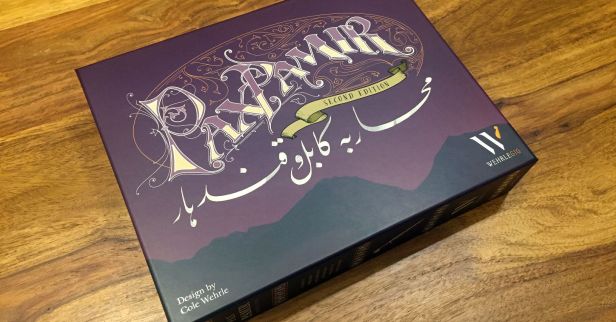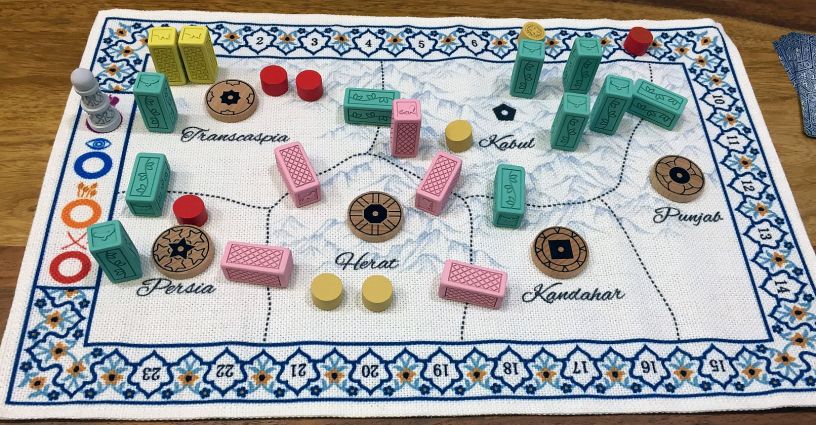| About game plus historical detail: | In Pax Pamir, players assume the role of nineteenth century Afghan leaders attempting to forge a new state after the collapse of the Durrani Empire. Western histories often call this period The Great Game because of the role played by the Europeans who attempted to use central Asia as a theater for their own rivalries – mainly British and Russians. In this game, those empires are viewed strictly from the perspective of the Afghans who sought to manipulate the interloping foreigners for their own purposes. In terms of game play, Pax Pamir is a pretty straightforward tableau builder. Players spend most of their turns purchasing cards from a central market, then playing those cards in front of them in a single row called a court. Playing cards adds units to the game’s map and grants access to additional actions that can be taken to disrupt other players and influence the course of the game. That last point is worth emphasizing. Though everyone is building their own row of cards, the game offers many ways for players to interfere with each other directly and indirectly (like bribing, eliminating or removing!). To survive, players will organize into coalitions. Throughout the game, the dominance of the different coalitions will be evaluated by the players when a special card, called a “Dominance Check”, is resolved. If a single coalition has a commanding lead during one of these checks, those players loyal to that coalition will receive victory points based on their influence in their coalition. However, if Afghanistan remains fragmented during one of these checks, players instead will receive victory points based on their personal power base. Would you stand-up to the task and manage to prevail against odds, leading your tribe to success in The Great Game? |
| Number of players: | This is fantastic game in a sense that it very elegantly scales from 1 (solo) to 5 players. The sweet-spot is a usually around 3, maybe 4 – but make no mistake, all allowed counts give very good game-play experience. |
| Playing time: | Having possibility to play from 1 to 5 players plus to finish the game with Sudden Death (possible already on 2nd out of four Dominance Cards) the game can finish within 20-30 minutes or last for 2-3 hours. My usual sessions – 3 players, rather experienced – results in approximately 1.5 hours of play. |
| Complexity: | While the rules are not overly complex, you need to wrap your head around the concept of the game, building the court, market and especially coalitions and flexibility to change allegiance. All in all I would call it a medium-complexity wargame. |
| What I like: |
|
| What I do not like or would like to see in the game: |
|
| For whom? | Definitely great title for all the fans of historical wargames, bringing so much information about not so well known events. Of course, also superb title for the fans of Cole Wehrle! |
| More about the game: | |
And now let us have a look at the components – all from the actual games we played:

VERDICT:

We are getting a very interesting and beautiful position. First, the historical period covered here is pretty exotic but at the same time you can learn a lot of interesting things out of it. Secondly, the graphical layer of this position will leave you jaw-dropping – it is not only how the game looks like but also feels (just touch those components!). As it can give you fun for many hours in various player set-ups, you definitely should not hesitate to get it!





Love this game and I need to get it to the table again soon. Thanks for the review!
LikeLiked by 1 person
Indeed, this is great game and is now available on Rally the Troops!
LikeLiked by 1 person